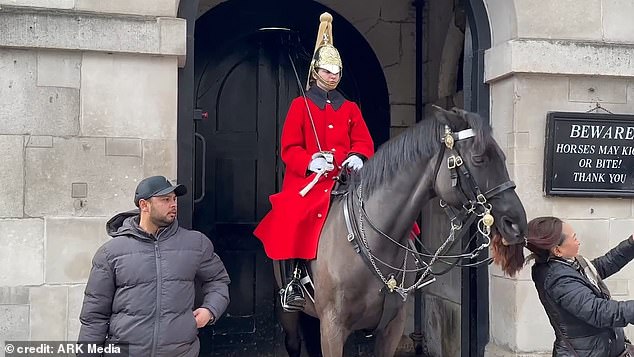Share this @internewscast.com
For many, a trip to London is not complete without a visit to see the Changing of the Guard.
While some tourists from foreign countries arguably are unaware of the custom and the job of the King’s Guard, others deliberately taunt and tease them in the hope of a reaction.
Based outside Buckingham Palace and St James’s Palace, the King’s Guard is made up of highly-trained soldiers.
The King’s Life Guard are mounted soldiers based at the official main entrance to both St James’s Palace and Buckingham Palace.
Signs are placed around areas where the Guards are positioned, warning the public that the horses may bite or kick if they get too close.
The soldiers are on duty ‘at their post’ for two hours and come to attention every 10 minutes.
They are subject to strict rules including not being permitted to eat, sleep, smoke, sit, or lie down during their tour.
Smiling is also strictly forbidden and they must maintain a stoic demeanor.

Watch your pony tail! Some tourists have been known to ignore signs warning them that the Guard horse can bite or kick

A man is confronted by members of the public after he attempts to communicate with a Guard

A man is escorted by police after angering a King’s Life Guard
Many guided walking tours involve a visit to the Changing of the Guard ceremony at Buckingham Palace or St. James’s Palace which typically happens once a day, usually at 10.45am and lasts for about 45 minutes.
The Guards are depicted in film and TV as stoic, oddly-dressed emotionless soldiers in giant, furry hats and red jackets.
In an episode of the TV show The Simpsons, the main character gets trampled and beaten by the Guards when he gets in the way of the Changing of the Guard.
Due to an increase in people interfering with the Guards’ job, as well as incidents where the Guards have had to discipline tourists for disrespectful or dangerous behaviour, more of the sentry posts have been moved away from the public.
Most recently, ropes were installed between the sentry posts at Windsor Castle and the public after an incident occurred between a sentry and a tourist who was mocking him, pretending to march alongside him and eventually grabbing the shoulder on which his rifle was resting.
Guards have been trained to respond to any attempts to touch or harass them, and this could involve yelling, physical confrontation, or even arrest.
In one clip two tourists were recorded posing for a photograph next to a mounted Guard and got much too close to the horse.
The Guard moves the reins and the horse appears to bite – or at least muzzle – the man.

When one woman made to stroke the horse’s face, it bit down on the arm of her jacket. Refusing to let go, it tugged on the jacket and pulled her back and forth and up and down before finally releasing it

Guards have been trained to respond to any attempts to touch or harass them, and this could involve yelling, physical confrontation, or even arrest

Other clips show the Cavalry Blacks grabbing people who get too close by their hair or shoulders, a clear signal for them to move away
The horses used by the King’s Guards, or Household Cavalry Mounted Regiment (HCMR), are known as Cavalry Blacks.
They are not a specific breed but rather a type of horse that meets certain height, color, and conformation standards.The ideal Cavalry Black is typically a black horse, often Irish-bred, with a mix of thoroughbred and Irish Draught breeding.
The horses undergo extensive training for their duties, including desensitization to crowds, loud noises, and heavy traffic.
This training prepares them for the rigorous parades and ceremonial duties they perform, ensuring they remain calm and focused in various situations.
In another example a man approaches a mounted Guard and asks: ‘Can I ride him?’
He speaks into a small, handheld microphone and positions it to the Guard, expecting them to react.
He argues with people in the crowd who tell him to stop what he is doing.
He is then seen being confronted by two police officers.
Other clips show the Cavalry Blacks grabbing people who get too close by their hair or shoulders, a clear signal for them to move away.
One female tourist who went in search of a photo with one of the famed Guard got a lot more than she bargained for, while the horse in question left no one in any doubt that it was up to the task of protecting the monarch.
In a video clip , the young woman is seen positioned in line with the horse’s head, ready for her photo opportunity.
While a sign next to the Guard warns onlookers that horses may kick or bite, the woman can’t resist raising her hand in an attempt to stroke the animal when it tilts its head to nuzzle her.
Yet as she does so, the horse bites down on the arm of her black puffer jacket and is soon tugging at it in an increasingly aggressive manner.

An elderly military veteran was treated to the friendlier side of a member of the King’s Life Guard when the soldier moved closer to her and allowed the woman to pat his horse’s nose
The Guards have access to an emergency button which they can press for assistance when confronted with disruptive tourists.
But it’s not all doom and gloom.
In 2023 a video posted on social media shows a couple – both of whom were proudly displaying their medals – moving as close as they dare to the mounted soldier.
But, having apparently realised they have both served their country, the soldier, who is wearing his customary plumed helmet and armour, quickly urges his horse closer to them before allowing the woman to pat his steed’s nose.
Beaming, the couple then move away and the soldier directs his horse back into position.
The touching scene came a few days after a member of the Life Guard moved closer to a boy with Down’s Syndrome outside Horse Guards Parade.
The boy was with his carer, who warned him not to get too close as they posed for a photo.
The King’s Guard unexpectedly moved next to them both, leaving carer Mike van Erp – better known by his YouTube name CyclingMikey – to declare: ‘What a nice man, what a cool thing to do.’
One thing which remains very clear is that tourists such be respectful when visiting the Guard and not attempt to touch or get too close to them.
What many may see as common sense seems to be lacking for a number of tourists who think they can recreate scenes from TV or create a viral video from the Guard’s reaction.
While the Changing of the Guard ceremony is definitely a great experience for tourists to watch, they should always read the signs and keep in mind the famous advice: ‘Don’t anger a horse’.









